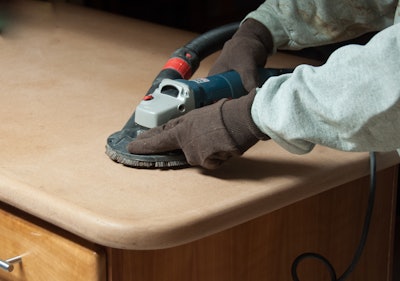
One thought about marketing favorable concrete attitudes to residential homeowners is to promote the sale of concrete kitchen countertops. Though there is very little concrete involved homeowners see it and use it every day. That can be either good or bad depending on the durability of the work; if a countertop is causing problems they will see that every day also. You might think countertops are in a safe environment for concrete but the reverse is true. They are regularly subjected to acid from vegetables, stains from food, efflorescence from water spillage, fat and oil attacks on sealers, scratches, and heat from hot pots when they are placed on them. Contractors must be skilled and knowledgeable. Greg Hyde, the owner of Hyde Concrete in Annapolis, Maryland, sums it up by saying that being a concrete countertop contractor isn’t for the faint at heart. Still, when all goes well countertops can be a creative expression, will perform as promised, and can encourage owners to want more concrete; a driveway, patio, or a concrete home as the ultimate way to provide a safe environment and an energy efficient structure.
Current trends
People like concrete countertops for a variety of reasons. One advantage is that any shape can be created—if it can be formed it can be cast. Concrete countertops can also be integrally colored, stained, or tinted with dyes. That said, many design professionals still choose to leave concrete its natural gray color. A current trend continues to be mixing concrete with colored glass aggregates or special natural aggregates. Countertops can be precast or cast-in-place (CIP) although most precast them under controlled conditions. Precast counters are almost always cast upside down to take on the finish of the form underneath. Surfaces can be diamond polished to achieve very shiny surfaces, left with the finish provided by the form, or with diamond honed finishes of 100- or 200-grit that create a more lustrous finish.
In the beginning years concrete countertops were reinforced with rebar but the current trend is to use structural fibers such as fiberglass, basalt, or metallic—Rebar being added to sensitive areas. Concrete mixes have changed also. There are many proprietary bagged products on the market but contractors also buy admixture packages to add to their own mixes. Polymers are also frequently added to retain water for curing, add flexural strength, and improve density.
What contractors are doing
Concrete Innovations. Charlie Griffasi, the owner of Concrete Innovations, located in Buffalo, New York, says he started out as a flatwork contractor, performing that work for 30 years. Then with his son Jason they started the International Concrete Polishing and Staining Conference (ICPSC). By 2006 they decided to get out of flatwork contracting and concentrate on diamond polishing floors. Reasoning that most concrete countertops were diamond polished, they decided to do that too. He says they do most of their marketing on the Internet which includes help from Jim Peterson's Concrete Network website. Their business is all precast and they have a showroom in downtown Buffalo where customers can look at countertops and make selections. They use two different concrete mixes for their counters; lightweight concrete made from a prepackaged mix and GFRC concrete which they spray into their molds.
Customers in Griffasi’s service area particularly like decorative affects such as adding special aggregates and exposing them by diamond polishing, applying dyes during the polishing cycle, and imbedding glass pucks in the work. He says the most creative work they do is commercial bar tops.
They seal their inside counters with Trinic’s H-12 urethane product.
Cornerstone Decorative Concrete. Troy Lemon’s company is located in Fennville, Michigan, located near the Lake Michigan coastline. He says that peoples desires change by the different regions he serves. “A national fixer-upper showed the installation of a rustic countertop, causing people to like the “rustic look”. One customer called me wanting that look and I achieved it with a CIP installation. I sprayed different colors of concrete into the form to achieve a worn type appearance.”
Lemon has included fiber optic lighting in his countertops but that isn’t currently something customers want. They prefer clean and simple looks now. Most of his countertops are made with GFRC by adding chopped fiberglass into his mixes. His standard countertop thickness is ¾ inches thick, showing 2 inches on the faces. Building counters for high-end cottage owners on Lake Michigan is his current bread-and-butter business.
Hyde Concrete. Greg Hyde says his company serves the Washington DC and Baltimore area. He says he constructed his first countertop over 10 years ago. Today it is a small part of his business but one that he wants to grow. So he is setting up a separate company to focus on this work. He is looking to develop product lines that can cast many units from the same molds and be sold at one time. He considers this custom work but thinks it is more profitable than doing a one-of-a-kind custom job that requires special forms. A goal is also to focus on being a precaster and leaving installation work to other contractors.
Here is what people want in Hyde’s region:
- “Waterfall” countertops and tables. This design calls for the top to make a right angle turn and extend to the floor, becoming leg support.
- Fire features are a popular trend in common areas.
- Customers often want large sinks for commercial and common residential areas that make a statement about the décor of the locations.
- Natural colored concrete is the clear preference but he says they are doing some work with cream and teal colored work.
- They occasionally imbed “Black Beauty” sand blasting medium on the fresh surface of the concrete to create a pronounced salt-and-pepper look.
- Exposed Mother-of-Pearl is still popular.
- On a recent project for Amtrak, the company supplied him with railroad tie spikes and crosscut sections of rails to imbed in their counters.
Hyde uses his own concrete mixes but buys admixture packages from Trinic (as well as their sealer) to control placement characteristics and add strength. Most of their countertops are GFRC and he adds post-tension reinforcement rods when counters start to get long. These rods are threaded on both ends and are inserted through a formed inset hole at each end of the form. When the concrete reaches its design strength the rods are stressed by tightening the nuts on each end of the rod. By doing this they have created counters up to 16 feet long and safely transported them.
Almost all their work is diamond honed to a 100-or 200-grit finish—a very basic finish in the world of diamond polishing—and finished with Trinic’s sealer.
Hyde prefers not to stain their countertop pieces because they pose too many issues over time. They also don’t cast-in-place anymore because the cost/benefit ratio isn’t there. He adds, “If a customer tells me they are also looking at granite tops I tell them to buy them. The price of granite has dropped so low I can’t compete. But if they want oversized pieces or customized creative work we can become part of the conversation—especially when they are developers.”
Sealing countertops
Sealing countertops isn’t an option, it’s a requirement. In the past waxes, penetrating sealers, epoxies, and acrylics have been used to seal indoor work and they each have their problems. Two of the contractors interviewed for this article are using two-part urethanes sealer made by Trinic LLC based in Kirkwood, New York. Bob Chatterton owns the company and says he started his career as a concrete contractor, forming and placing concrete. “We stained and sealed one job and the sealer failed. I quickly learned how frustrating and expensive repairs can be.” The experience became one of his motivations to start Trinic in 2010 to make a polymer admixture for GFRC concrete work. He wanted it to be a dry chemical admixture instead of a liquid and quickly learned that it wasn’t easy to achieve. Then they decided to create a thin-film water based, two part urethane that could be used to seal concrete and the product they introduced after much experimentation is called H-12. He says that epoxy films are much thicker than urethanes and unlike epoxies; urethane are very scratch resistant and tough. They recommend four applications, each coat mixed with different amounts of water to achieve good penetration. The finish that results enhances color and provides a luster finish. Urethanes are very resistant to acids, fats and oils, scratching, and can withstand up to 400ºF temperatures—Chatterton doesn’t recommend that owners put pots from the stove onto the counter though.
Chatterton says the cost of their urethanes can be an issue for some customers but sealer applications can make or break how a job turns out and it’s a main reason for customer callbacks.
Closing thoughts
It appears there are fewer contractors making concrete countertops now and that isn’t necessarily bad. The companies that make them are perhaps are more aware of the problems and issues. People are attracted to this product because its creative possibilities but this requires contractors with experience and know-how to build them so that the work is resilient—that countertop may just influence owners to install concrete driveways, patios, and concrete houses.




















